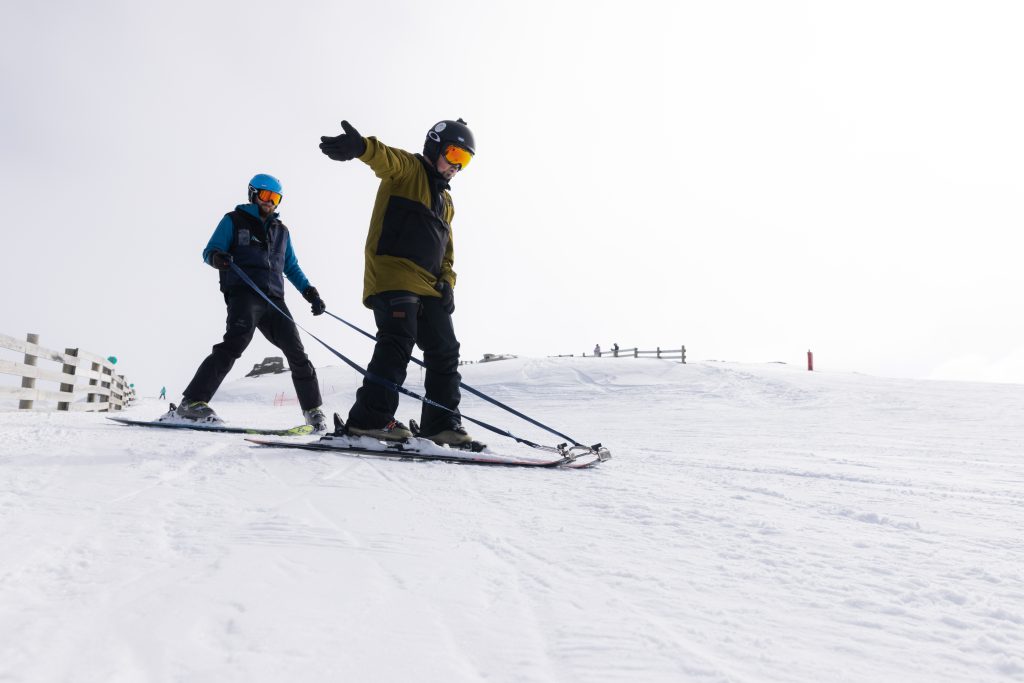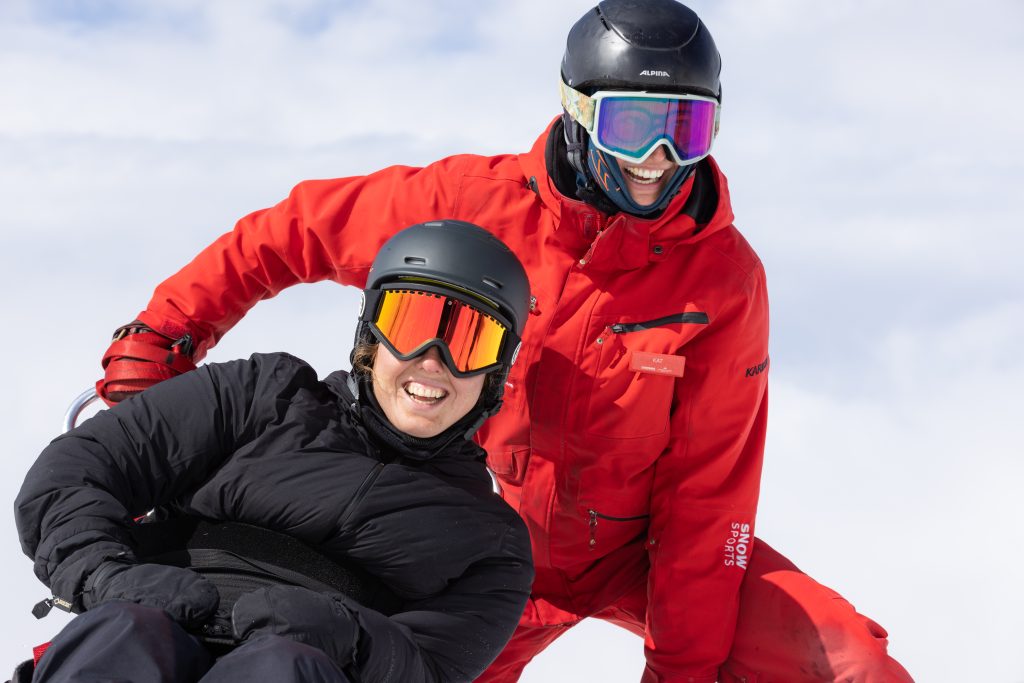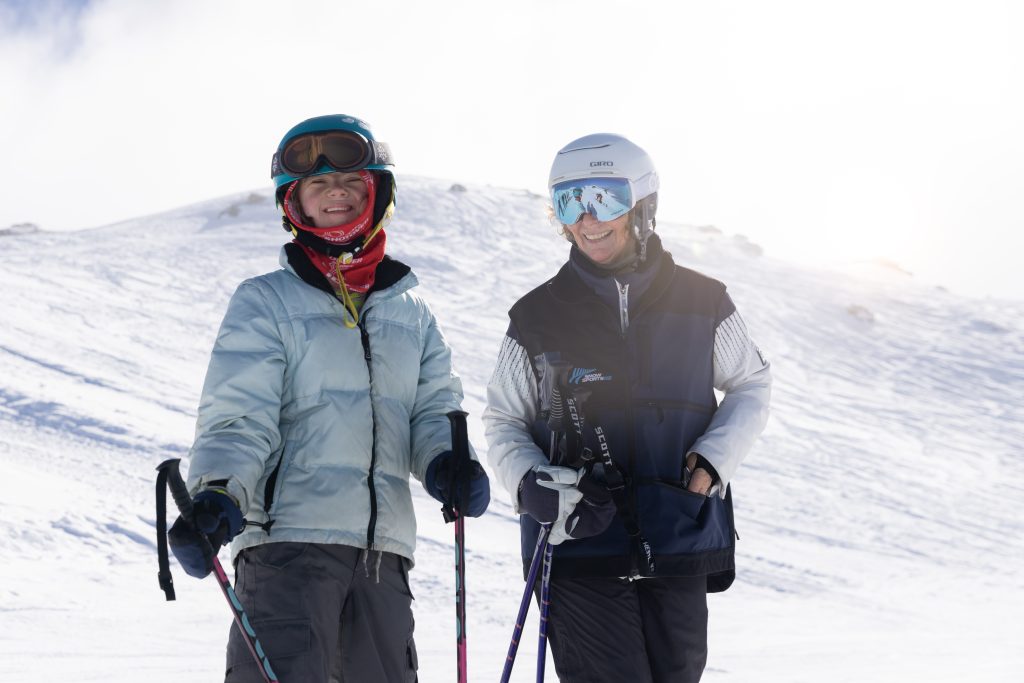The meaning of adaptive.
Bailley Unahi knows all about the journey from beginner to competitive athlete. Originally from the Southland town of Winton, Bailley was 19 when her spine was broken in a balcony collapse at a Six60 concert in Dunedin. She had been athletic before the accident, playing “every team sport possible”, including netball and rugby. Finding her way back into sport was a big part of the “how do you do life again” adjustment after her injury.
Bailley had only skied a few times, on school ski trips to The Remarkables when she was in Year 7 and 8. “I was so bad,” she laughs. As part of the recovery process in Burwood Hospital, patients are introduced to sports like wheelchair basketball and swimming. Bailley recalls seeing a photo of a sit-ski and thinking, “there’s no way I’m doing that, I couldn’t even ski standing up.”
Then she was invited by Parafed Otago to try the Cardrona Adaptive Programme and decided to give it another go. “There’s a lot to figure out: how to get in and out of the car, how to get on and off the mountain, how to get in and out of the sit-ski. Then, because you are sitting, the ski feels very far away from you. I fell a lot. But there were some successes, like getting one turn.” She is still friends with her instructor from that day.
The next weekend, she went up the chairlift. “I got that feeling, and I realised once you can get on the chairlift, you can ski the same runs as everyone else. On a sit-ski, you are a skier.” A naturally competitive person, Bailley started to set goals: to drive up the hill by herself, to ski by herself, to get on and off the lift. “It’s the next challenge after the next challenge. I can turn, I can stop, I can ski faster, I can ski off piste, I can ski moguls, I can ski powder.”
—

Today, I’m shadowing an adaptive ski lesson, and, like the student I’m with, I’m learning as we go. We’re at Cardrona Alpine Resort, making turns down Weston’s Trail off McDougall’s Chondola. The visibility is in and out, but the snow is perfect, spring-grippy and smooth.
Our student is a young man with limited mobility from the upper chest down. He’s on a bi-ski and holds an outrigger in each hand. He tells me he started on a mono-ski, but it was too tippy. He’s timing his movements to initiate each turn early enough for the ski to catch a bit of gravity as it changes direction, which will help it come around. Sometimes he goes too soon, and ends up tipped over, head pointed downhill. Sometimes he goes too late and picks up an alarming amount of speed before reigning it in by traversing. Abled bodied or not, if you have ever learned to ski or snowboard, you will recognise both these scenarios. You will also recognise this: everyone is laughing; the mountain air feels great on our faces; later, we’ll all be telling stories about the day.
Most people are familiar with adaptive snow sports for two reasons: they’ve seen equipment like outriggers or sit-skis out on the hill (and often wondered how they work) or they’ve watched the Paralympic Winter Games. New Zealand athletes have competed in two of the six Winter Para disciplines, Para alpine skiing and Para snowboarding, and have won 35 medals, including 17 golds – skiers like five-time Paralympic medallist Adam Hall and four-time medallist Corey Peters are household names in Aotearoa.
Competitive Para skiing has three main categories: visually impaired, standing, and sitting. The athletes race in the same classes as able-bodied skiers: Downhill, Slalom, Giant Slalom, Super-G and Super Combined. (The Downhill Sitting, for which they reach speeds of more than 100kph, is peak-y viewing.) Para snowboarding has three classes based on limb impairments, with races in Snowboard Cross and Banked Slalom.
But adaptive snow sports are way more varied than can be accommodated by the rules of competition. As Cardrona Adaptive Snow Sports Manager Kat Müller explains, “you can’t really categorise or generalise” the levels or types of assistance skiers and snowboarders will require. There are three broad types of needs covered: physical, cognitive and sensory. But then it gets complicated. According to Kat, physical could include anyone who uses a wheelchair, either due to a spinal cord injury or because of a condition like muscular dystrophy, and amputees, and stroke survivors, and people with cerebral palsy. Within those groups are infinite permutations of range of movement, strength, proprioception, left- or right-sided dominance, height and weight. Sensory might mean total blindness or someone who struggles with contrast in the white-on-white alpine environment. Cognitive could be, for example, a person with behavioural differences who is a confident skier, but who is overwhelmed by big crowds. Whatever it is, Kat’s team of specially-trained instructors and volunteers are up for it.
Then there’s the shedful of equipment. Sit-skis (with either a mono-ski or more stable bi-ski setup), frames, outriggers (three-track, which is one ski and two outriggers, or four-track, two skis and two outriggers), tethers (held by an instructor or volunteer to help control the descent), ski links (the hold ski tips together), each item modifiable to fit individual needs. There’s a lot of tinkering. It’s a gear-head’s dream.
Kat started in adaptive in 2019 as a volunteer and now manages the Cardrona Adaptive Snow Sports Programme, which runs at Cardrona and Treble Cone Alpine Resorts. It’s a big job – in 2022 they delivered more than 350 sessions – and she does it well, deservedly winning the 2022 New Zealand Snowsports Instructors Alliance (NZSIA) Instructor of the Year award. She talks clearly about not just the technicalities of adaptive work, but less tangible aspects like etiquette and attitude. “We don’t force anyone to do anything they are uncomfortable with,” she explains. When she is working with clients, she always asks before helping, with a lift into the sit-ski, for example, or to put on a glove. She also understands and respects how confronting a return to sport can be for someone with a recent injury. “The process can be really hard, and you need resilience,” she says. “But for a lot of people, just being able to do it again, being out there feeling that freedom, is huge.”
Kat emphasises the range of opportunities on offer through a programme like Cadrona’s. It’s more than just lessons. “We can provide someone with a volunteer to join them in a ski school group, so they can be with their peers. And there are so many small and easy ways of supporting people that can make a huge difference.” For example, an outrigger can turn someone who can’t physically ski into someone who can. “There is always a way to get into, or back into, snow sports if that is what you want to do.”
—

Winter sports for people with disabilities began to take off after World War II, when a high number of injured soldiers and civilians were looking to return to the snow. In 1942, Austrian war amputee Franz Wendel had become the first disabled person on record to enter a ski race; he used a pair of crutches with short skis attached to them, a precursor to the three-track outrigger technique. In 1965, two ski instructors from Oregon published ‘Amputee Ski Technique’, America’s first guide to adaptive skiing. By 1976, the inaugural Paralympic Winter Games were held in Ornskoldsvik, Sweden, and New Zealand contested its first Winter Paralympics in Geilo, Norway in 1980.
Whether it be competitive or recreational, anyone who has engaged with adaptive snow sports in New Zealand over the last three decades will have crossed paths with Jane Stevens. The current Para HP Programme and Pathway Manager at Snow Sports New Zealand (SSNZ), Jane became an Adaptive Ski Examiner in 1995, and has taught, coached and advocated in New Zealand and abroad since the early nineties.
Jane, who is from rural South Canterbury and grew up skiing on local hills like Ohau, Dobson and Tekapo, says she got involved in the adaptive scene after working with people with disabilities as part of her PhysEd degree. She also had a friend who used a wheelchair and skied, which piqued her interest. “Why shouldn’t people with disabilities get up the hill?” she thought.
After getting an early adaptive qualification through the NZSIA, “I kind of went down that road. I was fascinated.” Back then, the scene was volunteer-run and very DIY. “We often had to build things in back sheds and figure it out for ourselves,” she recalls. But Jane says one thing that hasn’t changed since then is her process of starting by asking “what are people capable of?” and going from there. “I want to look at the capability, instead of the perceived disability.”
Teaching and coaching, she points out, are all about how a person’s body works in relation to a ski or a snowboard. “It’s no different from teaching a class of able-bodied people. Sometimes you can tell by the way people are walking towards you how they’re going to ski. With adaptive, it’s just a more thorough assessment.”
Today, she is more focussed on high-performance (especially with the 2026 Milano Cortina 2026 Paralympic Winter Games imminent), but she notes that SSNZ is involved at every level. “Part of our remit is to provide opportunities all the way through. There’s a pathway from enjoying time with friends and family, up to becoming a Paralympian. My philosophy is, if someone says to me ‘this is my goal’, then I’ll work really hard to help them achieve it.”
—
Bailley decided to take her skiing to the next level after attending the Adaptive Snow Sports Festival at The Remarkables in 2018 and seeing the potential for a competitive pathway. The first step was her own sit-ski – she had been renting gear, for which she is appreciative, but it was not ideal. “There’s lots of admin and mucking around adjusting every time”. Grantmakers like the Lions Club and Rotary Southland helped cover the cost of the $20,000 frame, skis not included. (The frame snaps into a binding like a 25mm boot, and because of the weight of the rig, sit-skiers are constantly breaking skis. Side note: if you’ve got any spare single skis between 150cms and 210cms, she’d love you to send them her way.)
Then Bailley did what a lot of us do in our early twenties: headed overseas. Except she was still (very) new to using a wheelchair, and to skiing. “I had never travelled before my injury. I always thought there would be another tomorrow. So I thought, I will make it happen.” In 2019, having finished her Bachelor of Occupational Therapy, she and a friend boarded a plane on Boxing Day and flew to Canmore, Alberta for the Canadian winter. A lot of learning followed, including how to deal with wheels seized to her chair from the salt on the road. Then, just before her first scheduled race, Covid hit.
She finally got back to Alberta, this time to Cochrane, for the 2022-23 season, which was an “adventure”, one which included discovering the accessible accommodation was a Motel 8 with no kitchen (her and her flatmates cooked in on a hotplate in the bathroom) and that the local accessible bus could only take two wheelchairs at a time. (One of her mates eventually modified a second-hand Chevy Cavalier sedan to make it hand-controlled. Duct tape was involved.)
But she got to race, and train, and see ice hockey, and mix with an international community of athletes. “I’ve got friends all over the world now.” Two seasons in Europe followed (don’t get Bailley started on navigating the Paris Metro in a wheelchair), and she has been training with the Para Alpine Development Squad with the aim of one day representing New Zealand at the Winter Paralympics. For now, though, the immediate goal is to get into the backcountry. “I want to go heli-skiing,” she says, both to test the boundaries, and showcase the potential, of her sport. After all, she says, “sit-skiing is so cool. It’s epic.”
—

Although it’s no longer fully volunteer-run, volunteers still play a big role in the Adaptive ecosystem. Dean Bell has been helping with the Cardrona programme for a decade. He got involved, he says, after moving to Wānaka 12 years ago, and deciding that he wanted to do more than “go up and down the mountain”. Even after 10 years, he says he gets more back from volunteering than he puts in. “It’s really humbling,” he says. “Their condition doesn’t define who they are.”
He especially loves working with non-verbal skiers, where the feedback is all “smiles and grins.” Dean tells one non-verbal boy he works with to make some noise if he’s really enjoying things. “You can hear him when he’s going fast; he’s just screaming his head off. People wonder, but his mum says, ‘he’s having a great time!’” Like Kat and Jane, what strikes Dean most is the variety of people he skis with. “Adaptive is a really good word. Every single person is different, and you are always adapting. That’s the beauty of it.”
But it’s Ferdia O’Connell and Reuben Beston from Mint Charitable Trust who probably express it best. Mint supports people with intellectual disabilities in the Upper Clutha region. The team had previously gone to Cardona for social ski days, but this year is heading up more regularly, including as part of the new Adaptive Ride Tribe, an adaptive version of the long-running multi-week ski and snowboard programme for local kids. For Ferdia, who has been skiing since he was little, the highlight is “skiing at McDougall’s with my friends”, not to mention the hot chocolates with marshmallows. Having started skiing when he was four (“between dad’s legs,” he recalls), Reuben’s favourite is Captain’s Basin, which is “a bit steeper, a bit faster and a bit longer. It’s nice when it gets softer.” He always looks forward to the snow in spring. “Me too,” says Ferdia. Don’t we all.
LAURA WILLIAMSON
PHOTOS: SUPPLIED, EXCEPT TOP PHOTO BY ROSS MACKAY
Get involved! If you or someone you know is interested in Adaptive Snowsports, check out the Adaptive section on Cadrona’s website (cardrona-treblecone.com/lessons/adaptive-lessons) or contact Snow Sports NZ (snowsports.co.nz). SSNZ Adaptive members get discounted passes, rentals and lessons at Cardrona, and the team can also connect you with adaptive programmes at other ski areas.

